Dude! Take Your Turn!
A Gaming Life
Boardgame Geek Top 200 – Play or Played – #200-191
After finally getting the last post for the BGG Top 100 games done last week, I was a bit at a loss.
What to do for a follow-up?
I’m still not getting many games played and while I am behind on a review or two (would be even more if my review copy of The City would actually get through Canada Customs!) ultimately there’s not a lot to write about.
Then I got to thinking: people really seemed to like me posting about a bunch of games, some of which I’ve never played so really don’t have anything to say about.
So why not keep the ball rolling and count down from #200 to #101?
Ok, ok, I did kind of spoil it by mentioning the possibility in the post last week.
So sue me.
I’ve discovered that I like writing about games, even those I haven’t played much of, if at all, and I wanted to keep doing it.
Consider it my COVID go-to topic.
It gives me something to write about.
And there was much rejoicing…
Let’s see if we can set a record for how many blurbs are in one post.
So on that note, let’s get started!
#200 – Dixit: Odyssey (Libellud) – 2011

Designer: Jean-Louis Roubira
Artists: Marie Cardouat, Pierô
Dixit is kind of an abstract game in the sense that it all depends on your imagination and what you can come up with. It’s not abstract like Chess, but it’s abstract like Pictionary.
In the game, the player whose turn it is chooses one of the cards in their hand with almost dream-like artwork and comes up with a phrase or word that one of them could represent. They then place the card face-down on the table.
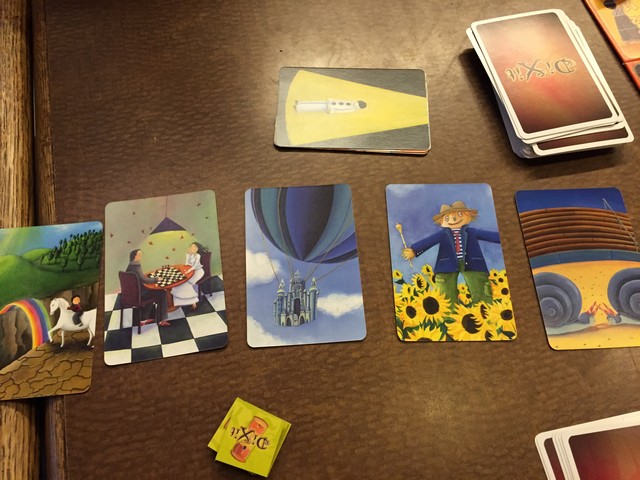
Each other player chooses a card from their hand that could also be referring to that phrase/word and also places it face-down.
Once all cards are revealed, each player secretly guesses which card is the original player’s.
If not everybody guesses the correct card, then they and you get points! If all players guess correctly, you get no points but they do! If nobody guesses correctly, then nobody gets points except for other players whose cards are chosen instead. Each player also gets points for each other player who guessed their card instead of the correct one.
You play until the deck runs out or somebody has a set number of points and whoever gets there and has the most is the winner!
Dixit has multiple expansions and all of them appear to be standalone with new cards and new artwork. There are definitely enough cards in this one to play it without the original game, but you can play this with the original game if you wish.
I’ve only played the original edition, so I haven’t played with these new cards but the experience is largely the same.
The game is a bit too esoteric for me, unfortunately. Not that many people don’t love this game, but it just forces my brain into places that it doesn’t really want to go.
I’ve had this trouble with other games like this where you have to look at cards with dreamy artwork and try to figure out a word/phrase that the card would fit, and it’s just very difficult for me.
Moreso when it’s not my turn and I have to choose a card that kind of fits what another player has chosen, but even when it’s my turn I find it very difficult.
That being said, the game is a lot of fun and you can come up with some really crazy rationales for why you chose the card you did.
It’s not something I would choose to play often, but I’ll try it again once after a long period of time not having played it (I haven’t played it since 2015, but I have played a similar game back in January so I think I’ve had my fill for a while).
Again, nothing against the game. It’s just not how my brain works.
#199 – Seasons (Libellud) – 2012
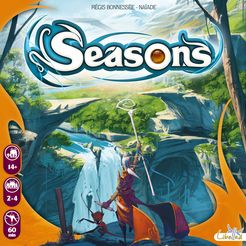
Designer: Régis Bonnessée
Artists: Régis Bonnessée, Xavier Gueniffey Durin, Stéphane Gantiez
Seasons, on the other hand, is a pretty cool game that I just never really got into when I got it to the table.
I played it a bunch on Boardgame Arena back a few years ago, but haven’t for a little while now.
It’s been 4 years since I got it to the table and then traded it away shortly afterwards.
Not sure exactly why that is, because I do remember enjoying it on BGA.
It’s a combination dice/card drafting game. At the beginning of the game, you draft cards that you will then have in your hand.
During each round, season dice will be rolled that can then be drafted to give you the proper type of energy to play your cards, or perhaps to execute the effect of one of your cards.
Let’s blurb this thing since it’s been 4 years and I don’t really remember the details.
“Next comes the Tournament: at the beginning of each round a player will roll the seasons dice (dice = number of players +1).
These cubes offer a variety of actions to the players:
– Increase your gauge (maximum number of cards you may have placed on the table and in play)
– Harvesting energy (water, earth, fire, air) to pay the cost of power cards
– Crystallizing the energy (during the current season) to collect crystals. Crystals serve both as a resource to pay for some cards, but also as victory points in the end.
– Draw new cards
Each player can choose only one die per turn. The die not chosen by anyone determines how many fields the “time track” would move forward.
In addition, all the dice are different depending on the season. For example, there are not the same energies to a particular season. Throughout the game, players will therefore have to adapt to these changes – also the “exchange rates” of energy to crystals vary during seasons – the energy not present on the dice in any given season is also the best paid during the season.”
I do really like how each season has its own set of dice and the same types of energy will not appear on each one. You have to be really aware of what season it currently is and what types of faces will be on the dice that are rolled.
I’m not really sure what happened with this game. I received it in a math trade because I had enjoyed it on BGA. Then it never really got to the table until I finally got it played with my wife.
And neither one of us really cared for it.
I’m not sure if it was too fiddly or what.
I was so entranced with it that I forgot to take a picture of it. (Sorry).
Again, it’s not really a bad game. I’d like to try it again on BGA to see if I still like it when I’m not having to do all of the fiddly table-top stuff with it.
But it just didn’t stick with me and make me want to keep the game (it helps that I got something I really wanted for it when I traded it away, though I can’t for the life of me remember what that is…go figure).
#198 – Age of Empires III – Age of Discovery (Tropical Games) – 2007

Designer: Glenn Drover
Artists: Paul Niemeyer, Jacoby O’Connor, James Provenzale
This is a game I have no inkling of what it is, except that it’s a civilization game based on the popular video game at the time.
Each player takes on the role of a colonial power (uh oh) trying to expand their empire, harvest resources, and seeking fame, gold and riches in the New World. Get off your ass and start exploring!
I have never even seen this game much less played it, so let’s do a blurb.
“Designed by Glenn Drover, this boardgame allows you to revisit the age of exploration and discovery. Take on the role of a colonial power seeking fame, glory, and riches in the New World. As you proceed through three ages, you can launch expeditions of discovery, colonize regions, expand your merchant fleet, build capitol buildings that give your nation distinct advantages, develop your economy, and, if necessary, declare war.”
Apparently it’s a 5-player game that can be played with 6 players if you have pieces of another colour or the Builders expansion. The expansion also had some new tiles as well.
I wish I had more to say about this game, but I really don’t even have any idea what I might say.
I guess I enjoyed the video game? Though Real-Time Simulations were never my bag. I can’t think fast enough (though you could always pause the game while you figured out what you needed to do).
Actually, I’m not 100% sure this is based on the Age of Empires III video game. For some reason I remember a game based on the video game and it had a similar name, but his may not be it.
Or it might be.
So does this win the award for most confusing entry of all time on this blog?
(Editor – you could ask that about almost every post)
Let me know in the comments.
#197 – Dungeon Petz (Czech Games Edition) – 2011
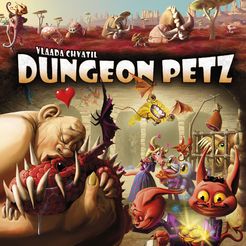
Designer: Vlaada Chvátil
Artist: David Cochard
Dungeon Petz is a game that I’ve only played on Boiteajeux.net, and even that was a long time ago. Even with the rulebook, the game beat my brain in really hard so I’m not quite sure I understood it.
I’m sure that would change with playing it on the table (or maybe a digital edition, hint hint Czech Games???)
I think I played it once, though I played its predecessor Dungeon Lords a few more times.
That one also beat my brains in.
It was a really messy time at my computer table for a while there.
Since I’m really not that familiar with the game, let’s blurb it.
“Dungeon Petz is a standalone game set in the Dungeon Lords universe. The game consists of several rounds in which players use unusual worker placement mechanisms (players simultaneously prepare different sized groups of imps in order to play sooner than others) to prepare themselves for the uneasy task of raising creature cubs and pleasing their different needs (represented by cards) in order to sell them as grown and scary creatures to Dungeon Lords. In the meantime, they also attend various contests in which they show off their pets, scoring additional points.”
I do remember thinking the game was pretty cool, but since nobody in our game group had it (it is a 2011 game, so, you know, ancient and everything), I knew I’d never see it on the table.
I’d love to get it to the table once though just to see if I could figure it out.
That’s one of the bad things about playing electronically (which has been heightened by this whole COVID thing where everybody’s playing electronically): it’s really hard to teach a game when you can’t lay out a few cards to show people what’s what. You can’t do a “demo” of the game to demonstrate the points in the rules you want to highlight.
So maybe one day I will play this.
I wouldn’t hold my breath, but you never know!
#196 – 1960: The Making of a President (GMT Games) – 2007

Designers: Christian Leonhard, Jason Matthews
Artists: Josh Cappel, Donal Hegarty, Rodger B. MacGowan
And then we get to an even older game, but it’s in my Top 5 games of 2019 (and probably would be in my Top 5 of all time if I did that list right now).
Granted, I have played the 2012 GMT Games version and not the 2007 Z-Man version, but still…
This is a card-driven game about the 1960 election between John F. Kennedy and Richard Nixon.
Jason Matthews is one of the co-designers of Twilight Struggle and this has a lot of similarities.
It also has one major difference that makes me prefer it to that Cold War game (even though this is all the way back in the 190s and Twilight Struggle is in the Top 10).
Before I say that, though, let me describe the game.

The game takes place over 9 rounds, in which there is a Debate turn towards the end of it. Each round (except the Debate) has 7 phases, the first 5 of which you will be playing cards from your hand.
Each player has a hand of cards that they can either play for the points to campaign in various states, buy media ads, or add cubes to one of the three major issues.
Or you can play it for the event if the event favours you.
“Political Capital” above can be played by the Nixon player to draw 2 cards. Or he can play it for the 2 Campaign Points that he can use for campaigning/media/etc.
So what’s the difference between this and Twilight Struggle?
In that game, if you played an opponent’s event, it automatically happened, either before or after you spent the points (your choice).
In 1960, you have to spend a Momentum marker in order to have the event take place. If you don’t want to, or (heaven forbid) you don’t have one, then you can’t take advantage of the event.
I love how that adds to the strategy of the game.
If your hand is full of your opponent’s events, you can play the cards in an order where you really have to make your opponent think about whether they want to spend that valuable Momentum. Maybe you’re holding a card back that they’d rather play?
Or, if you have them, you can spend 2 Momentum tokens to prevent the other player from even getting that choice.

You’re campaigning all across the US trying to spread your influence to different states to get those very valuable Electoral College votes that each state has, so you also have to pick and choose your battles.
When you “add” influence, if your opponent has cubes there, you end up just subtracting their cubes. Only one candidate’s cubes can be in any given state. So for Illinois above, Kennedy would have to spend 5 campaign points to even get one cube into the state after removing 4 Nixon cubes.
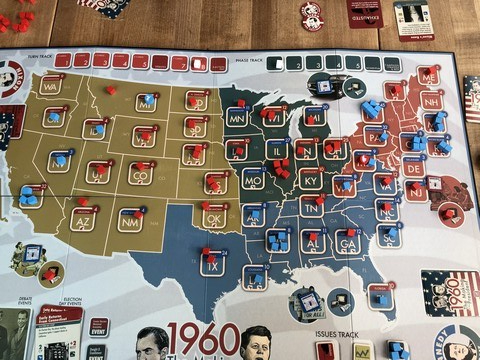
At the end of the game (9 rounds which includes the debate), you add up the Electoral College votes for each state (plus any Election Events that were played earlier in the game) and whoever has the most votes is the new President!
The interesting thing too is that in the last two rounds, you will be holding back cards that can potentially add influence for you just before the Election.
Also, I love the “support check” mechanism. There is a bag full of cubes from both sides. If you try to add support in states that are heavily going for your opponent, you have to pull cubes from the bag. If you pull your cube, great! If you don’t, then too bad. The campaigning didn’t have any effect.
There’s a lot more to this game than just this simple explanation.
I’ve played it twice and I really want to play it again.
Being a 2-player game, it doesn’t get a lot of play at our game days, but I really do want to get it out again.
#195 – Roll Player (Thunderworks Games) – 2016

Designer: Keith Matejka
Artists: JJ Ariosa, Luis Francisco
Ah, another game that I really wanted to play but never really had the chance to.
Until a boardgame marathon in October 2018 where a friend of mine had brought the game.
Now, one play later, it’s definitely one that I want to try again.
So much so that it’s been one of my (way too many, some would say) COVID purchases to play with my wife!

In Roll Player, you are essentially rolling up one of your role-playing game characters. However, depending on what type of character you are, you will only get points if your attributes (Strength, Dexterity, Intelligence, Wisdom, Constitution and Charisma, which are all the main attributes in Dungeons & Dragons, but probably other games as well) are in a certain range.
You will be doing this by drafting dice each round and assigning them to a certain one of your characteristics.
Your class will get you certain bonus points for each attribute depending on what total score you end up with in that stat.
You can also get points for your backstory (above I was an Aristocrat) which will give you points if you can get certain colours of dice in the appropriate spot on your character sheet.
Finally, you have alignment which can shift depending on what cards you buy from the market. Your alignment will shift into one of nine different categories, and your Alignment Card will tell you how many points you will gain (or lose!) depending on where your alignment ends up.
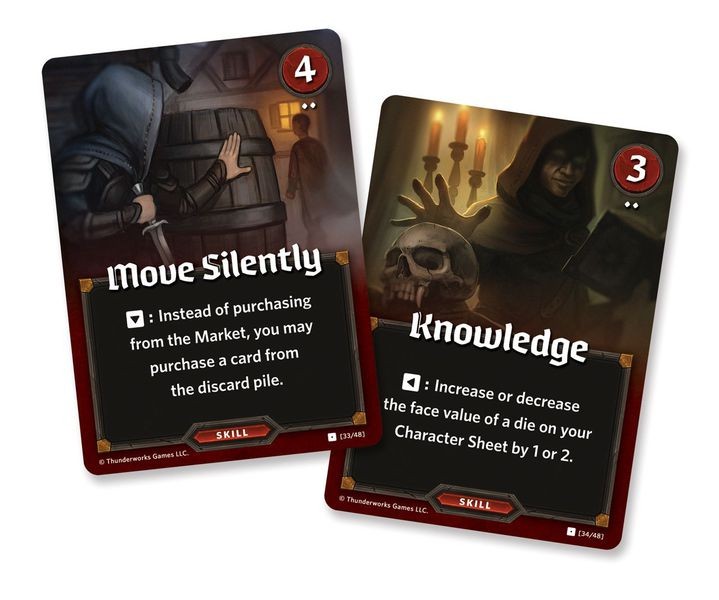
You can buy equipment and skills from the Market which will affect all of this, or which may just give you reputation points at the end of the game. These cards may also let you adjust your dice, which is even better!
Expansions for this game actually have you using the character you’ve rolled up, but I haven’t played any of those.
Roll Player itself is such a good game and I’m happy that I finally got to play it.
Even happier that I’ve now bought it and am waiting to pick it up from the Post Office (though I may have already done so by the time this posts).
I used to play Dungeons & Dragons back when I was a kid, and this made me really nostalgic.
#194 – Bora Bora (Ravensburger) – 2013

Designer: Stefan Feld
Artist: Alexander Jung
Oh my, a Feld game! Since some people seem to think that you should be buying a Stefan Feld game sight unseen with little idea of what the game actually is (see the upcoming Castles of Tuscany where we literally have no idea of what the game is about but pre-orders are open), I’m sure this game is something that everybody should play!
(And then somebody posts the rulebook to Castles of Tuscany between me writing this and me posting this…but I’m leaving this in anyway!)
I have to admit that while I’ve heard of it, I have no idea what the game is about.
It’s another Feld dice game where dice are used to choose actions that are available for players to put use. The more players, the more actions so your choice is always extremely limited.
Let’s blurb since again, I’ve never even seen this game, much less played it.
“In Bora Bora, players use dice to perform a variety of actions using careful insight and tactical planning. The heart of the game is its action resolution system in which 5-7 actions are available each round, the exact number depending on the number of players. Each player rolls three dice at the start of the round, then they take turns placing one die at a time on one action. Place a high number on an action, and you’ll generally get a better version of that action: more places to build, more choices of people to take, better positioning on the temple track, and so on. Place a low number and you’ll get a worse action – but you’ll possibly block other players from taking the action at all as in order to take an action you must place a die on it with a lower number than any die already on the action.”
It does sound extremely interesting, along with most Feld dice games where you are using dice that you roll in order to choose actions that will have more of an effect the higher the roll (admittedly Castles of Burgundy only cares about whether or not the dice match the places that you want to put your tiles, but still…)
It sounds like an interesting one, though I’m not sure how different it will be from other Feld dice games.
Is it worth checking out?
I’d love to play it once just to see what I would think.
Would I feel like I’m on a Pacific island, getting away from it all like I am on my current month-long vacation?
Probably not, since I’m not rolling dice to see where we should go each day this month.
But it might still be fun!
#193 – Flamme Rouge (Stronghold Games) – 2016
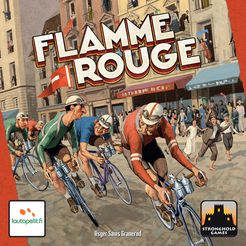
Designer: Asger Harding Granerud
Artists: Ossi Hiekkala, Jere Kasanen
Bicycle racing! I would never have thought a game on bicycle racing would be so popular, but a lot of people really love this game.
I have to admit that I’ve never played it, though I did see it played a couple of times at Dice Tower West (with the illustrious Stephen Buonocore helping out!)
Flamme Rouge just hasn’t shown up to my game days so I’ve never had the opportunity to play it.
If Buonocore was playing it at a con, I’d be right there, though.
It’s an interesting-sounding game, though, with each player running two bikes on the track and the card deck you’re playing with depleting as you use some of the cards.
Let’s blurb this since I’ve never played it:
“Flamme Rouge is a fast-paced, tactical bicycle racing game where each player controls a team of two riders: a Rouleur and a Sprinteur. The players’ goal is to be the first to cross the finish line with one of their riders. Players move their riders forward by drawing and playing cards from that riders specific deck, depleting it as they go. Use slipstreams to avoid exhaustion and position your team for a well timed sprint for the win.”
Doesn’t that sound cool?
(Don’t answer that if you find bike racing extremely boring).
I’ve always been intrigued by this one but since I’ve never had the opportunity to play, it hasn’t made my radar too much.
Maybe at a con one day?
Stephen, if you’re reading this (Ha! I know how likely that is), if I ever get the chance to play this at a convention with you, I am totally stoked for that.
#192 – Imperial (Rio Grande Games) – 2006

Designer: Mac Gerdts
Artist: Matthias Catrein
Mac Gerdts has a ton of games designed that all sound really interesting, though whether or not they’re for me is debatable. I do love me some Concordia (because I love trading in the Mediterranean…actually, I just love the concept of Concordia and how the card play interacts with where your trading posts are), but this one has always sounded a bit above what I’m interested in.
This appears to be a heavy economic game about the time where European nations were investing in the new world and their own empires.
Should we blurb it?
Yeah, we should blurb it. The vodka is telling me we should blurb it.
“Europe in the age of imperialism. International investors try to achieve the greatest influence in Europe. With their bonds, they control the politics of the six imperial nations: Austria-Hungary, Italy, France, Great Britain, the German Empire, and Russia. The nations erect factories, build fleets, and deploy armies. The investors watch as their nations expand, wage wars, levy taxes, and collect the proceeds. Since the European nations are under the shifting influence of different investors, new strategic alliances and conflicts arise between them again and again!”
Each player represents an international investor. Only he who succeeds in increasing his capital and gaining influence in the most powerful European nations will win the imperial competition.
Imperial is a varied strategy game without the luck of dice or cards. Two to six players, from about twelve years and up, take on the role of imperial investors. The duration of the game is about two to three hours.”
While I do like Brass, that description is kind of making me leery of the whole thing.
Heavy economic games aren’t really my forte, though I will play them if it’s something everybody else wants to play.
There is the Imperial 2030 edition of the game that apparently does update things. That came out in 2009.
Are either of these in print?
That’s a good question.
And one I don’t know the answer to.
Still, I’d play this if I was asked to.
#191 – Imperial Settlers (Portal Games) – 2014
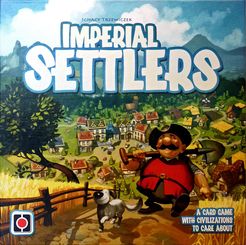
Designers: Maciej Obszański, Ignacy Trzewiczek
Artists: Mateusz Bielski, Tomasz Jedruszek, Jarosław Marcinek, Rafał Szyma
I really did love Imperial Settlers the one or two times I played it, but when I bought it and a bunch of expansions, I for some reason couldn’t get it to the table again.
It’s not because it’s a bad game.
Instead, it’s a matter of buying a bunch of the expansions and then trying to figure out how you should deal with the game and how to “deck build” the deck that you draw cards from.
This is a perfect example of how a game could be made worse by the expansions. I bought the first couple of expansions along with the game and then I started getting intimidated by all of the “how should I decide what cards should be in the draw deck when I have this expansion or that expansion?” questions that I saw on BGG.

Imperial Settlers is something that I really enjoyed the few times that I played it, but I bought this game and then it never got played again.
I do really like how you can play cards on either the right side of your player board (“neutral” cards or cards anybody can play”) and cards on the left side (faction-specific cards).
There are three rows where your cards can go: Production buildings, Feature buildings, and Action buildings, and each action building can be used once per round (as long as you have the resource or people that will activate it).

Thus, the game is about making combos with your buildings, something I was never really that good at. You’re going to be activating buildings, using the materials produced by your production buildings, and trying to amass victory points through those actions (or sometimes just the buildings themselves).
But it was fun.
I did actually play the game that’s based on this, 51st State (the newest edition) a year or two ago and I really enjoyed that one too.
Or maybe this was based on the original version of that game?
I get so confused.
I’d like to get this to the table again and see whether it rekindles my enjoyment of the game.
Or maybe I’ll just go play 51st State again, which in my mind was just a tad better than this one (though I still sucked at it).
So there is the first of 10 posts about the first half of the Top 200 games ranked on Boardgame Geek.
I’ve played 4 games and one game was a digital-only game.
Not a bad start to the series!
Which of these games have you played?
Any that you love? Any that you hate? Any that make you wish I hadn’t decided to do this series because it’s lame?
Let me know in the comments.
Posts in this Series
#200-191
#190-181
#180-171
#170-161
#160-151
#150-141
#140-131
#130-121
#120-111
#110-101
That was tough for me. 2/10 – Imperial and Age of Empires. I really like imperial – you just fund the war, not being attached to any side and switching if the money is good. So real…
LikeLiked by 1 person
Ok, now you’ve made me want to play Imperial. Maybe one day! 🙂
So tell me, is Age of Empires based on the video game?
LikeLiked by 1 person
Imperial is not the newest game, but was a nice discovery for me.
AoE is similar to digital game only in the name. Completely different mechanics and timeline. Still nice game, but about colonization not civilization 🙂
LikeLiked by 1 person
Haven’t played a single one – but there are four I’d play in a heartbeat (1960, Roll Player, Flamme Rouge, Imperial)! Maybe at a convention? 🙂
As for AoE III: Yep, it’s based on the videogame. No idea how closely – I’ve played neither, but in my pre-teens I spent a lot of time with AoE and AoE II. I was horribly bad, though – they’re games that require you to click very fast and also find out which worker/building/etc. is idle right now. No lunch breaks there!
LikeLiked by 1 person
LOL maybe at the Essen where me and the wife come to visit you and you can show us around Germany! 🙂
Sorry this week was a bust for you, but at least there’s some games that you would like to play!
LikeLike
@boardgamechronicle Ah, so the game is more of an “inspired by” one?
That makes sense.
I kind of thought it wasn’t based exactly on the video game, but I couldn’t be sure.
And doing research would be painful! 😛
LikeLike
Pingback: Boardgame Geek Top 200 – Play or Played – #190-181 – Dude! Take Your Turn!
Pingback: BoardGameGeek War Game Top 60: #60-51 | Clio's Board Games
Pingback: Boardgame Geek Top 200 – Play or Played – 180-171 – Dude! Take Your Turn!
Pingback: Boardgame Geek Top 200 – Play or Played – #170-161 – Dude! Take Your Turn!
Pingback: Boardgame Geek Top 200 – Play or Played – #160-151 – Dude! Take Your Turn!
Pingback: Boardgame Geek Top 200 – Play or Played – #150-141 – Dude! Take Your Turn!
Pingback: Boardgame Geek Top 200 – Play or Played – #140 – 131 – Dude! Take Your Turn!
Pingback: Boardgame Geek Top 200 – Play or Played – #130-121 – Dude! Take Your Turn!
Pingback: Boardgame Geek Top 200 – Play or Played – #120-111 – Dude! Take Your Turn!